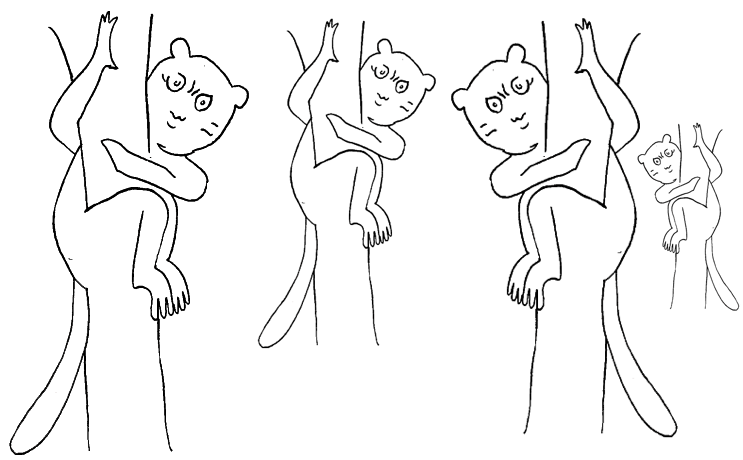
ハイチのヴードゥー芸術とポピュラー化
Haitian Vodou art and it's popularization

☆ ハイチ・ヴードゥー美術とは、ハイチ・ヴードゥー教に関連する美術である。この宗教は、奴隷によってハイチにもたらされた西アフリカの伝統宗教にその起源 を持つが、ヨーロッパやアメリカ大陸の要素も取り入れられ、進化を続けている。ヴードゥー教の芸術形態で最も特徴的なものは、スパンコールやビーズで装飾 されることが多い刺繍の旗であるドラポ・ヴードゥーであるが、この用語は絵画、刺繍の衣類、粘土や木製の像、楽器、組み立て品など、幅広い視覚芸術形態を カバーしている。1950年代以降、観光客やコレクターの間でヴードゥー教の芸術に対する需要が高まっている。
★ 大 衆文化では、ハイチ・ヴードゥーやルイジアナ・ヴードゥーなど、異なる形態のヴードゥーに関連する慣習がさまざまな形で描写されてきた。また、アフリカ 系ディアスポラの宗教に帰属するその他の要素も含まれており、その表現は実際のヴードゥーの慣習や信仰とは大幅に異なる場合が多い。ヴードゥーを題材にし た作品は、超自然的なファンタジーやホラー映画に最も多く登場し、呪術師の活動、闇の精霊の召喚や支配、遠隔地にいる人間に苦痛を与えるためのブードゥー 人形の使用、ゾンビの創造などが共通のテーマとなっている。
Haitian
Vodou fetish statue of a devil with twelve eyes
| Haitian Vodou
art is art related to the Haitian Vodou religion. This religion has
its roots in West African traditional religions brought to Haiti by
slaves, but has assimilated elements from Europe and the Americas and
continues to evolve. The most distinctive Vodou art form is the drapo
Vodou, an embroidered flag often decorated with sequins or beads, but
the term covers a wide range of visual art forms including paintings,
embroidered clothing, clay or wooden figures, musical instruments and
assemblages. Since the 1950s there has been growing demand for Vodou
art by tourists and collectors. |
ハイチ・ヴードゥー美術とは、ハイチ・ヴードゥー教に関連する美術であ
る。この宗教は、奴隷によってハイチにもたらされた西アフリカの伝統宗教にその起源を持つが、ヨーロッパやアメリカ大陸の要素も取り入れられ、進化を続け
ている。ヴードゥー教の芸術形態で最も特徴的なものは、スパンコールやビーズで装飾されることが多い刺繍の旗であるドラポ・ヴードゥーであるが、この用語
は絵画、刺繍の衣類、粘土や木製の像、楽器、組み立て品など、幅広い視覚芸術形態をカバーしている。1950年代以降、観光客やコレクターの間でヴー
ドゥー教の芸術に対する需要が高まっている。 |
| Origins and history Art historians disagree on the origins of Haitian Vodou arts. Suzanne Blier makes the case that they come from the coastal areas of Benin and Togo. Robert Farris Thompson makes a plausible connection with Central Africa based on similarities with nkisi figures from the Kongo, and cosmograms, flags, drums and dances from that region.[1] The first slaves from West and Central Africa were brought to the Caribbean in the 16th century. Europeans often claimed that the slaves were being rescued from devil worship. However, the slaves maintained their religious practices in secret, and their priests were among the leaders of the first revolt in Haiti in 1791.[2] Haiti became the first independent nation of African people in the Western Hemisphere in 1804 under President Jean-Jacques Dessalines.[3] The traditional religion continued to be banned, and as late as the 1940s the Catholic church undertook a campaign against Vodou, ransacked temples and burned religious artifacts. Many of the techniques of sacred art have now been forgotten, and few sculptures were being made by 2001.[2] The Vodou religion was finally recognized officially in 2002.[3] The great majority of Haitians still practice the Vodou[a] religion. The religion continues to evolve, and in addition to the traditional West African lwo (spirits) it now includes the spirits of heroes of resistance to the colonial forces, and spirits of powerful religious leaders.[3] The iconography of the Haitian Vodou religion combines elements from Africa, Europe and the Americas.[4] Thus a drapo made for an African spirit may include an image of a Catholic saint. The saint's image was originally in part designed to deceive Catholic missionaries, but also was chosen in recognition of similarity between the saint and the lwa.[5] Since then the saint and the spirit have become syncretized.[6] |
起源と歴史 美術史家の間では、ハイチ・ヴードゥーの起源について意見が分かれている。スザンヌ・ブリエは、ヴードゥーの起源はベナンとトーゴの沿岸地域にあると主張 している。ロバート・ファリス・トンプソンは、コンゴのンキシ像や、その地域に伝わるコズモグラム、旗、太鼓、踊りとの類似性から、中央アフリカとの関連 性を主張している。 西および中央アフリカから初めての奴隷がカリブ海地域に連れて来られたのは16世紀のことである。ヨーロッパ人はしばしば、奴隷たちは悪魔崇拝から救われ たのだと主張した。しかし、奴隷たちは秘密裏に宗教的慣習を守り続け、彼らの司祭たちは1791年のハイチにおける最初の反乱の指導者の一人であった。 [2] ハイチは1804年、ジャン=ジャック・デサリン大統領の下で西半球におけるアフリカ系住民初の独立国となった。 。伝統宗教は引き続き禁止され、1940年代にはカトリック教会がヴードゥー教に対するキャンペーンを行い、寺院を荒らし、宗教的な物品を焼いた。神聖な 芸術の技法の多くは現在では忘れ去られ、2001年には彫刻もほとんど作られなくなっていた。[2] ヴードゥー教は2002年にようやく公式に認められた。[3] 大多数のハイチ人は今でもヴードゥー教を信仰している。[a] この宗教は今も進化を続けており、伝統的な西アフリカの精霊(lwo)に加えて、植民地勢力に対する抵抗の英雄の精霊や、強力な宗教指導者の精霊も含まれ るようになった。[3] ハイチ・ヴードゥー教の図像学は、アフリカ、ヨーロッパ、アメリカ大陸の要素を組み合わせたものである。[4] そのため、アフリカの精霊のために作られたドラポには、カトリックの聖人の像が描かれていることもある。聖人の像は、もともとカトリックの宣教師を欺くた めに一部意図的にデザインされたものだったが、聖人とルワの類似性を認識して選ばれたものでもある。[5] それ以来、聖人と精霊は融合するようになった。[6] |
Interpretation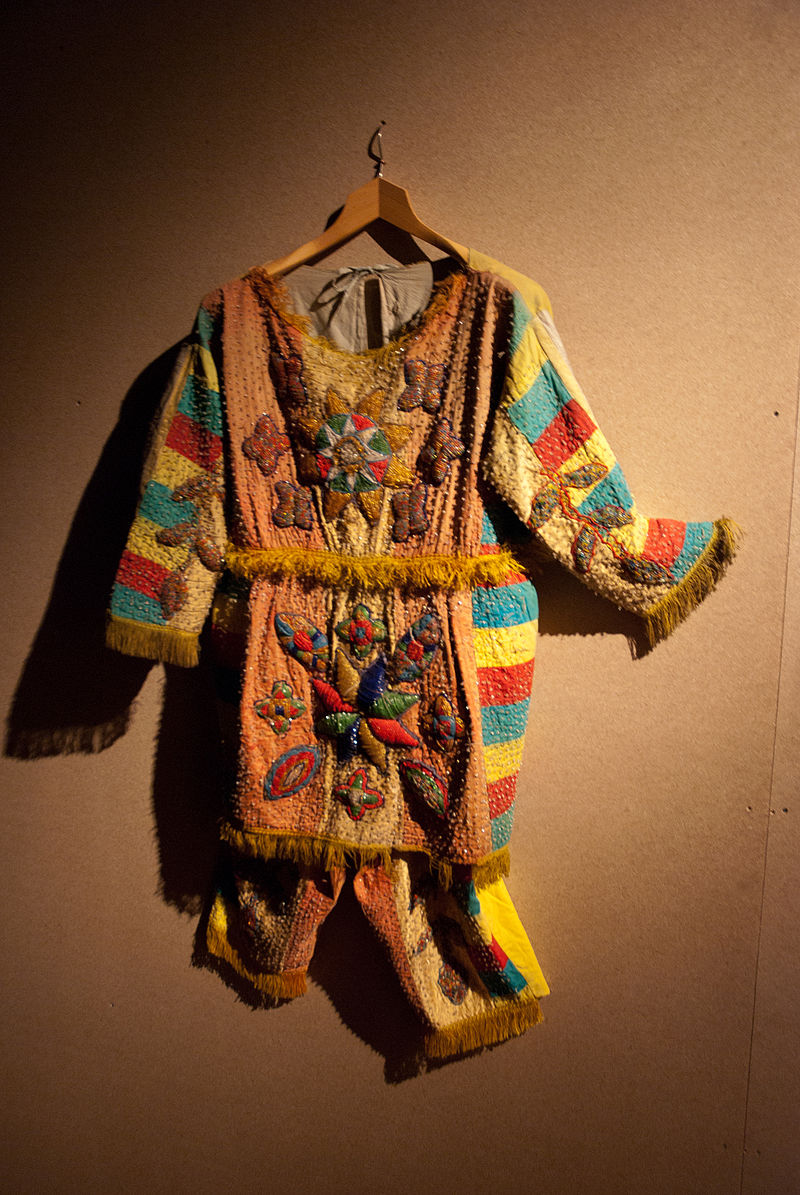 Antique ceremonial suit for Haitian Vodou rites Vodou art can be difficult to classify in Western terms. Rachel Beauvoir-Dominique, writing of Marianne Lehmann's[b] Vodou art collection, notes that "even today, the Creole language does not possess any word to designate what Western civilization qualifies as 'art'."[7] Poet and critic André Breton dismissed Haitian art, noting that Haiti had no museums or art collections. He apparently saw no value in the art associated with the "backward" Vodou religion.[8] Some scholars distinguish narrative Haitian art, which may include depictions of events or ceremonies in which there are many images from Vodou, from "Vodou art" in the sense of art that has a sacred function. The latter would be designed for use in ceremonies or for placement in temples or on altars. Given the omnipresence of Vodou in Haiti, most narrative art would also include Vodou images.[9] However, the fluid and adaptive nature of Vodou makes it hard to clearly distinguish religion, art and religious art.[10] Alessandra Benedicty points out that Western scholars are led by their postmodern intellectual framework into trying to explain Vodou art in terms of "intellectual truths". Vodou is open-ended and sometimes purposely dissimulates. Benedicty writes that in "the Vodou/Haitian aesthetic system, the objet d'art nurtures ambivalence and demands that the reader or the spectator interpret and thus participate in the production of an artistic text's meaning." If there is a veve in the work, there is a possibility that the lwa the work was made for will possess the viewer.[11] The purchaser of a Vodou altar or other artwork may be possessed by their purchase.[10] A 1995 exhibit at the Fowler Museum of Cultural History in California of "The Sacred Arts of Haitian Vodou" included dramatic ritual interactions between Vodouists and lwa that may have included possession.[10] |
解釈 ハイチ・ヴードゥー教の儀式用のアンティークの祭服 ヴードゥー教の芸術は、西洋の概念で分類するのが難しい。マリアンヌ・レーマンの[b]ヴードゥー教美術コレクションについて書いているレイチェル・ボー ヴォワール=ドミニクは、「今日でも、クレオール語には西洋文明が『芸術』と呼ぶものを指す言葉がない」と指摘している。[7] 詩人で批評家のアンドレ・ブルトンは、ハイチには美術館も美術品コレクションもないと指摘し、ハイチ美術を否定した。彼は明らかに、「後進的」なヴー ドゥー教に関連する美術に価値を見出していなかった。[8] 一部の学者は、ヴードゥー教の神々を多く描いた出来事や儀式の描写を含む「物語的ハイチ美術」と、神聖な機能を持つ美術品としての「ヴードゥー美術」を区 別している。後者は儀式で使用されたり、寺院や祭壇に置かれることを目的として作られる。ハイチではヴードゥー教が至る所に見られるため、物語を題材とし た芸術作品のほとんどにもヴードゥー教のイメージが含まれている。[9] しかし、ヴードゥー教の流動的で順応性のある性質により、宗教、芸術、宗教芸術を明確に区別することは難しい。[10] アレッサンドラ・ベネディクティは、西洋の学者たちがポストモダンの知的枠組みに導かれて、ヴードゥー教の芸術を「知的真理」という観点から説明しようと していると指摘している。ヴードゥー教は無限の可能性を秘めており、時には意図的に隠蔽する。ベネディクティは、「ヴードゥー教/ハイチ的美学体系では、 芸術作品は両義性を育み、読者や観客に解釈を求め、芸術的テキストの意味の創造に参加することを求める」と書いている。作品にヴェーヴが存在する場合、そ の作品が奉納された神が鑑賞者に憑依する可能性がある。[11] ヴードゥー教の祭壇やその他の美術品を購入した者は、その購入品に憑依される可能性がある。[10] 1995年にカリフォルニア州のファウラー文化歴史博物館で開催された「ハイチ・ヴードゥーの聖なる芸術」展では、ヴードゥー教信者と神との劇的な儀式上 のやりとりが展示され、その中には憑依も含まれていた可能性がある。[10] |
| Drapo A drapo Vodou is a handmade flag, typically embroidered and decorated with beads and sequins. Although flags may have been made in West Africa before the arrival of Europeans, the flags widely used there by 1600 were derived from European flags. They were used as symbols of ethnic, military or religious allegiance. The drapo Vodou also drew on Yoruba beadwork, Catholic vestments and Masonic aprons.[3] In the 19th century and early 20th century most drapo Vodou were made from one or two colored fabric pieces decorated with embroidery, metal bangles and glass beads, with an image of the lwa made of shiny fabrics appliquéd to the cloth using techniques still followed in West Africa.[3] Flags and banners used in the 21st century in rural areas often still have stylistically simple designs, in part due to the high cost of decorative material.[12] With the older flags the background field that frames the image was usually decorated with widely spaced sequins or beads. Modern flag makers often completely cover the fabric of the field with sparkling sequins of one color, or with intricate geometrical patterns. Borders, which were either simple or did not exist on early drapo Vodou, have evolved into highly elaborate patterns.[13] The use of sequins in modern drapos dates to 1940, when Joseph Fortine saw a troupe of Afro-Brazilian samba dancers wearing sequin costumes in a Carnival parade. Fortine began to decorate the costumes of Rara band players with sequins, and in 1943 made a drapo Vodou for Damballa from a burlap coffee sack which he stretched on a wooden frame. He made the image from sequin lines on a satin background, and added random sequins surrounding the image. Fortine taught his techniques to sequin artists such as Edgard Jean Louis, Sylva Joseph, Clotaire Bazile, and Yves Telemak. The youngest of these, Telemak, was the first to sign his work.[3] There are two kinds of drapo Vodou. The drapo servis are made for ceremonial use, and art flags are made for sale.[3] |
ドラポ ドラポ・ヴードゥーは、通常、刺繍が施され、ビーズやスパンコールで装飾された手作りの旗である。ヨーロッパ人が到着する以前から西アフリカでは旗が作ら れていた可能性はあるが、1600年までに広く使用されるようになった旗はヨーロッパの旗に由来するものであった。それらは民族、軍隊、宗教的な忠誠心の 象徴として使用されていた。ドラポ・ヴードゥーはまた、ヨルバ族のビーズ細工やカトリックの祭服、フリーメイソンのエプロンからも影響を受けている。 [3] 19世紀から20世紀初頭にかけてのドラポ・ヴードゥーの多くは、1~2色の布地に刺繍や金属製の腕輪、ガラスビーズをあしらったもので、 西アフリカで現在も用いられている技法で、光沢のある布をアップリケして神の像を布に縫い付けたものもあった。[3] 21世紀の農村部で用いられる旗やバナーは、装飾素材が高価であることもあって、様式的にシンプルなデザインのものが今でも多く見られる。 古い旗では、通常、画像を囲む背景部分に、間隔の広いスパンコールやビーズが飾られていた。現代の旗の製作者は、生地全体を単色のきらめくスパンコールや 複雑な幾何学模様で覆うことが多い。初期のドラポ・ヴードゥーにはボーダーはなかったか、あっても単純なものであったが、現在では非常に手の込んだパター ンへと進化している。[13] 現代のドラポにおけるスパンコールの使用は、1940年にジョセフ・フォートンがカーニバルのパレードでアフロ・ブラジリアン・サンバ・ダンサーの一団が スパンコールの衣装を身にまとっているのを目にしたことに始まる。フォートンはララ楽団の演奏者の衣装にスパンコールを飾り付け始め、1943年には木製 の枠に張った麻袋のコーヒー袋からドラポ・ヴードゥーを作った。彼はサテンの背景にスパンコールのラインで画像を作り、その周りにランダムにスパンコール を付け加えた。フォートンは、エドガー・ジャン・ルイ、シルヴァ・ジョセフ、クロテール・バジル、イヴ・テレマクといったスパンコールアーティストたちに 自身のテクニックを伝授した。このうち最年少のテレマクは、最初に自身の作品にサインをした人物である。 ドラポ・ヴードゥーには2種類ある。ドラポ・セルビスは儀式用に作られ、アートフラッグは販売用に作られる。 |
Drapo servis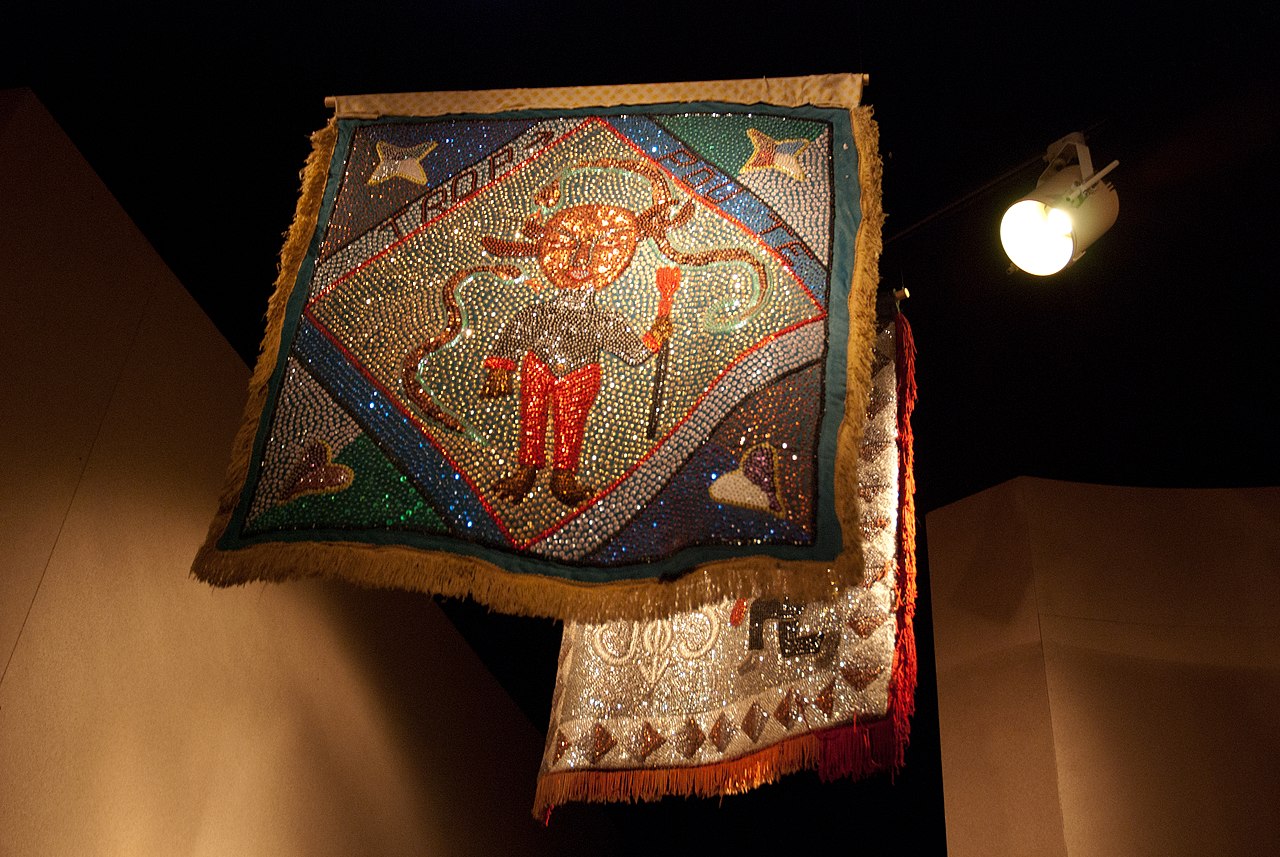 Haitian Vodou drapos. The front flag is for Trop Pou Te. The drapo servis are important religious icons. They are kept in shrine rooms, and carried by flag bearers in elaborate ceremonies in the main chamber of the temple. A drapo servis will include an image of a Catholic saint or a vèvè (trace-work emblem) of an lwa[c] (spirit) such as Papa Legba or Ogun of the Yoruba religion.[4] There are many lwas, including Erzulie, Gede, Damballa and La Sirene.[5] The purpose of a ceremonial drapo is to flatter the lwa in the hope of gaining favor in return.[5] Usually drapo servis are made in pairs, for example representing Ogun and Damballa. Ogun was the lwa who led the slaves to freedom, and Damballa is the snake, representing the life force. Ogun may be paired with other lwas.[3] A drapo servis will have a central image surrounded by a diamond-shaped border, will often have a fringe, and will be 36 by 36 inches (910 by 910 mm) in size. The image may depict a Catholic saint associated with an lwa or may be a veve that represents the lwa symbolically and provides a gateway for it to enter the world of humans.[3] The image may be a chromolithograph, a vividly colored paper image from Italy, Mexico or Spain of a Catholic saint that has been syncretized with the corresponding African spirit of the drapo. The image may be an outline of the saint traced from a chromolithograph, or may be a detailed and faithful copy of a chromolithograph in beads and sequins.[6] The most widely used images of saints are those of Saint Isidore, Saint James Major, Saint Patrick and the Holy Virgin.[6] Veves include the ship of Agwé, the cemetery cross of Baron Samedi, the crossroads of Legba and so on.[14] An image of a mermaid is used on flags for the water spirit LaSiren. This does not derive from veve or Catholic origins, but seems to have come from European nautical sources.[6] The image of a fish is important in Vodou as in Christian art, but the Vodou symbol comes from Fon mythology rather than Christianity.[15] It represents Agwé, who corresponds to the Fon sea deity Agbê. Agbê took the shape of a fish when he was given responsibility for the sea.[16] |
ドラポ・セルビスは ハイチ・ヴードゥー教のドラポ(旗)を奉っている。手前の旗はトロ・プー・テのもの。 ドラポ・セルビスは重要な宗教的象徴である。これらは神殿の神聖な部屋に保管され、神殿の主室で行われる精巧な儀式では旗持ちによって運ばれる。ドラポ・ セルビスには、カトリックの聖人の像や、ヨルバ教のパパ・レグバやオグンなどの精霊(lwa[c])のヴェヴェ(透かし彫りの紋章)が描かれる。[4] 多くの精霊がおり、エルズール、 エルズール、ゲデ、ダンバラ、ラ・シレーヌなどがある。[5] 儀式用のドラポの目的は、見返りとして恩恵を得られるよう、lwaを喜ばせることである。[5] 通常、ドラポ・セルビスはペアで作成され、例えばオグンとダンバラを表す。オグンは奴隷を自由へと導いたlwaであり、ダンバラは生命力を象徴する蛇であ る。オグンは他のlwaとペアになることもある。[3] ドラポ・セルヴィスには、菱形の枠で囲まれた中央の図像があり、たいていは房飾りがあり、大きさは36インチ×36インチ(910ミリメートル×910ミ リメートル)である。その図柄は、精霊と関連するカトリックの聖人を描いたものであったり、あるいは象徴的に精霊を表し、人間の世界に入るための入り口と なるベベ(veve)であったりする。[3] その図柄は、イタリア、メキシコ、スペインから輸入された色鮮やかな紙製の聖人の図柄で、それがアフリカの精霊と融合したドラポである場合もある。そのイ メージは、聖人の輪郭をクロモリトグラフからなぞったものかもしれないし、ビーズやスパンコールで細部まで忠実に再現されたクロモリトグラフの複製かもし れない。 聖人のイメージとして最も広く使用されているのは、聖イシドール、聖ヤコブ、聖パトリック、聖母マリアのイメージである。[6] ヴェーヴには、アグウェの船、バロン・サムディの墓地の十字架、レグバの十字路などがある。[14] 人魚のイメージは、水の精霊ラ・シレンの旗に使用されている。これはヴェーヴやカトリックに由来するものではなく、ヨーロッパの航海に関するものから来て いるようである。[6] 魚の図像はキリスト教美術と同様にヴードゥー教でも重要であるが、ヴードゥー教のシンボルはキリスト教よりもフォン神話に由来する。[15] これはアグウェを表しており、フォン族の海の神アグベに対応する。アグベは海の責任を任された際に魚の姿となった。[16] |
Art flags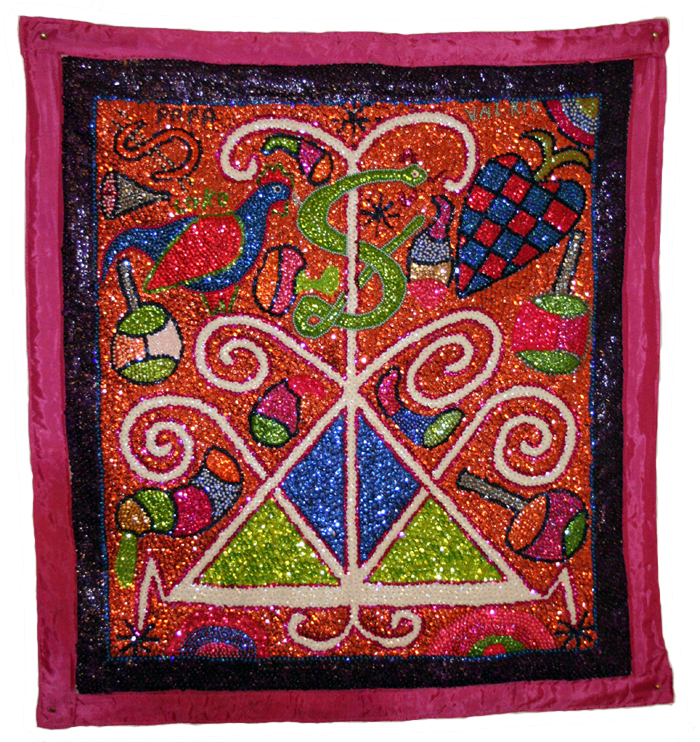 Flag by George Valris Art flags show much wider variation in size and theme than drapo servis, and rarely have a fringe. Some flags are closer to tapestries.[3] In the 1950s collectors started to buy drapo Vodou, and the oungan (priests) began to make them for sale as a source of income. The next generation of artists, active in the 1990s, included Eviland Lalanne, Joseph Oldof Pierre, Le Petit Frere Mogirus, Wagler Vital, Georges Valris, Roland Rockville, Ronald Gouin, and Antoine Oleyant. They introduced various innovations, in part driven by the shortage of materials for flagmaking. Antoine Oleyant has been called "the artist who really brought the flags into the realm of fine art."[3] In Port-au-Prince the skilled drapo artists have ready access to beads and sequins brought in from Canada and the United States. These artists earn their living from sales to tourists and to art galleries.[12] In the 21st century there have been considerable changes to drapo Vodou as an art-form, in which artists such as Myrlande Constant[d] have introduced new themes and techniques. Other contemporary drapo artists include Evelyn Alcide, Roudy Azor, Gabriel Chery, Lindor Chiler, Mireille Delice, Christian Dorleus and Josiane Joseph. Their large and elaborate drapo represent in greater details the interactions with the lwas in events such as Vodou ceremonies and weddings. They may also represent evangelical Christian themes, or have secular subjects.[5] Edgard Jean Louis, a well-known flagmaker, made a flag called "Diana Erzulie" that included a photograph of the English Princess Diana.[3] There is growing demand for such drapo by international art collectors.[5] |
アートフラッグ ジョージ・ヴァルリスによるフラッグ アートフラッグは、サイズやテーマのバリエーションがドラポ・セルヴィスよりもはるかに多く、フリンジが付いていることはほとんどない。一部のフラッグは タペストリーに近い。1950年代にはコレクターたちがドラポ・ヴードゥーを買い始め、ウンガン(司祭)たちは収入源として販売用に作り始めた。1990 年代に活躍した次世代のアーティストには、エヴィランド・ラランヌ、ジョセフ・オルドフ・ピエール、ル・プティ・フレール・モジラス、ワグラー・ヴィタ ル、ジョルジュ・ヴァリス、ローランド・ロックヴィル、ロナルド・グアン、アントワーヌ・オレヤンなどがいる。彼らは、旗作りの材料不足に追い込まれたこ ともあって、さまざまな革新をもたらした。アントワーヌ・オレヤンは、「旗を真に芸術の域にまで高めたアーティスト」と呼ばれている。 ポルトープランスでは、熟練したドラポのアーティストたちは、カナダやアメリカから持ち込まれたビーズやスパンコールを入手しやすい。これらのアーティス トたちは、観光客やアートギャラリーへの販売で生計を立てている。[12] 21世紀には、芸術形態としてのドラポ・ヴードゥーに大きな変化があり、ミルランダ・コンスタント(Myrlande Constant)[d]などのアーティストが新しいテーマや技法を導入した。その他の現代のドラポのアーティストには、エブリン・アルシード、ルディ・ アゾール、ガブリエル・シェリー、リンドー・チラー、ミレイユ・デリス、クリスチャン・ドルーラス、ジョジアン・ジョセフなどがいる。彼らの大規模で精巧 なドラポは、ヴードゥー教の儀式や結婚式などの行事における精霊との相互作用をより詳細に表現している。また、福音派キリスト教のテーマを表現している場 合や、世俗的な題材である場合もある。[5] 著名な旗職人であるエドガー・ジャン・ルイは、英国のダイアナ妃の写真を入れた「ディアナ・エルズリー」という旗を作った。[3] このようなドラポは、国際的な美術コレクターの間で需要が高まっている。[5] |
Other objects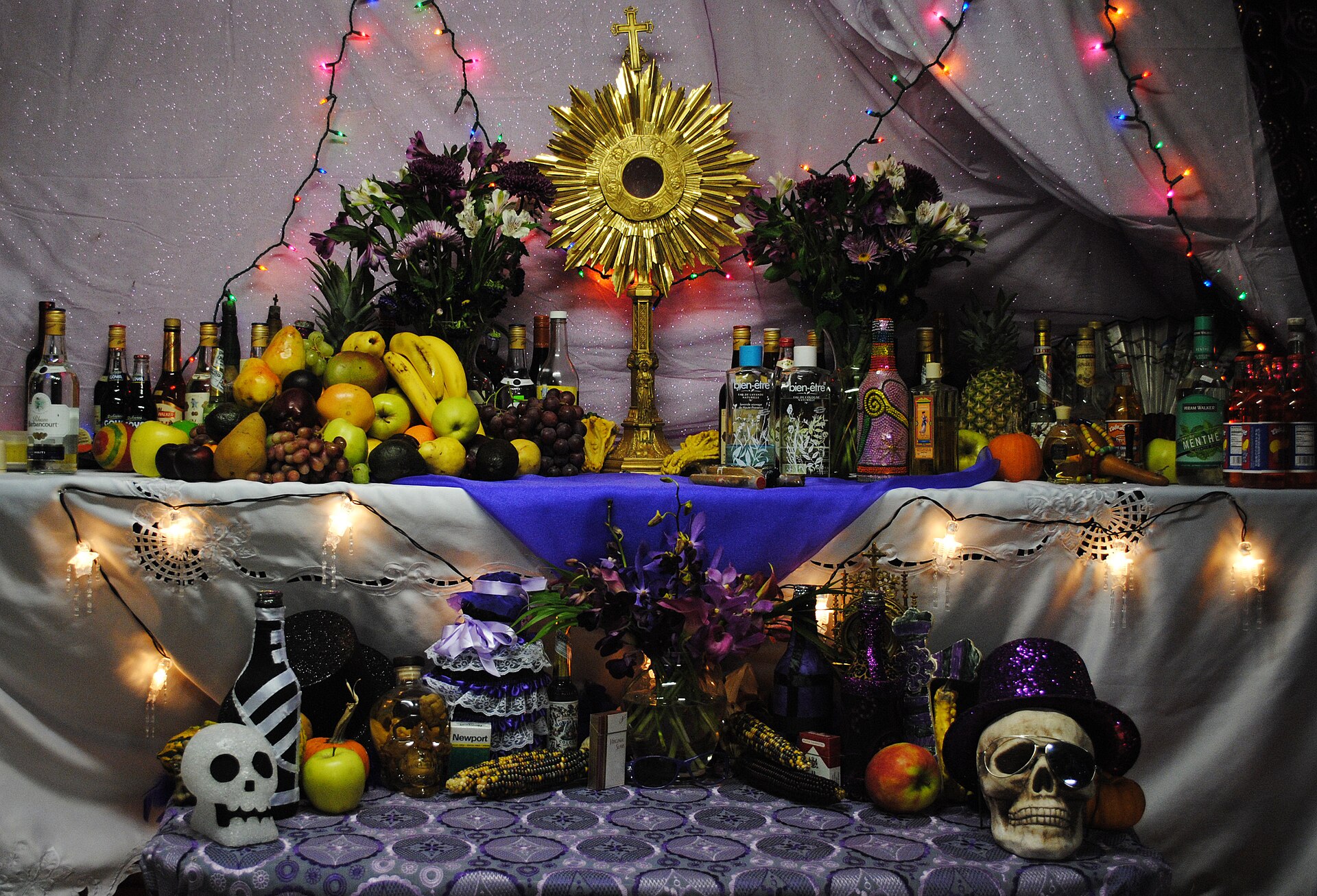 Altar to Petwo, Rada, and Gede spirits; 2010 In the 1940s Haitian professional artists began to create imitations of images provided by foreign entrepreneurs. The images represented the foreigners' view of the essence of Vodou art. This interaction was later dismissed and the Haitian works were stated to be authentic.[18] In 1949 fifteen artists decorated the Episcopal Saint Trinite Cathedral in Port-au-Prince with murals that contrast Vodou art and traditional scenes from the bible. Thirteen of the artists were Catholics and/or Vodouists.[19] In the 1950s the murals became world famous. African gods were found in the symbolism of Christian images. Thus the "Damballah Virgin" by Andre Dimanche was identified as Erzulie, a lwa connected to Aphrodite, Mater Dolorosa, health and an angry Madonna.[20] A doll incorporated in a work of Vodou art can be animated so it can perform supernatural work, protecting the home. The Haitian Vodou priest Georges René explains the process, saying "anything can do mystique if you believe in it... you have to turn it into mystic. You baptize it. You make a ceremony. You put the food the lwa eats... after that you can work with it. It gets a soul. You can put it on an altar."[21] Pierrot Barra (1942–99) and Marie Cassaise made sacred altar installations from everyday objects such as dolls, sunglasses, sequins, speedometers, rosaries, mirrors and tinsel.[22] Barra said his work was inspired by the Vodou spirits, who sometimes demanded it. He said, "When I sleep, while I'm dreaming, I see the Mysteries. When I sleep I see the spirits...they show me a design, some face, some kind of thing. Then when I wake up I create it."[23] A visitor to Port-au-Prince in 1991 described an altar installation Barra made for the mother goddess Ezili Dantor. Her head came from a plaster doll, with rouge, lipstick and white synthetic hair. She held a cutout picture of the baby Jesus, which represented the goddess's daughter Anais.[22] A red fabric snake was wrapped round the body of the goddess, and a small rubber baby doll was at the foot of the statue. The whole was decorated with sparkles and cheap jewelry. This was not a traditional design, but was immediately recognized by Vodouists as authentic Vodou art.[24] |
その他のオブジェクト ペトゥー、ラダ、ゲデの精霊を祀る祭壇、2010年 1940年代、ハイチのプロの芸術家たちは、外国の事業家たちから提供されたイメージの模倣品を作り始めた。これらのイメージは、ヴードゥー芸術の本質に 対する外国人の見方を表していた。この相互作用は後に否定され、ハイチの作品は本物であるとされた。[18] 1949年、15人の芸術家たちが、ヴードゥー芸術と聖書の伝統的な場面を対比させた壁画で、ポルトープランスにある聖トリニテ大聖堂を装飾した。アー ティスト13人はカトリック教徒および/またはブードゥー教信者であった。[19] 1950年代には、これらの壁画は世界的に有名になった。キリスト教のイメージの象徴主義の中にアフリカの神々が発見された。アンドレ・ディマンシュによ る「ダンバラの聖母」は、アフロディーテ、悲しみの聖母、保健、そして怒れるマドンナと関連する精霊であるエルズリとして識別された。[20] ヴードゥー教の芸術作品に組み込まれた人形は、超自然的な働きをすることができるよう命を吹き込まれ、家を守る。ハイチのヴードゥー教司祭ジョルジュ・ル ネは、そのプロセスについて次のように説明する。「信じれば何でも神秘的なものになる。それを神秘的なものに変える必要がある。洗礼を施し、儀式を行う。 神が食べる食べ物を置く。そうすれば、それを使って作業ができる。魂が宿る。それを祭壇に置くことができる」[21] ピエロ・バラ(1942-1999)とマリー・カセーズは、人形、サングラス、スパンコール、スピードメーター、ロザリオ、鏡、モールなどの日常的な品々 を使って神聖な祭壇を飾った。[22] バラは、作品はヴードゥーの精霊たちにインスピレーションを得たもので、時には彼らに要求されたものだと語っている。「眠っているとき、夢を見ているとき に神秘を見る。眠っているときに霊が見える...彼らは私にデザインや顔、何かの形を見せる。そして、私が目覚めたときにそれを創作するのだ」[23] 1991年にポルトープランスを訪れた人物は、バラが女神エジリ・ダントールのために作った祭壇の様子を説明している。女神の頭部は石膏の人形から作ら れ、口紅や口紅、白い合成繊維の髪が付けられていた。彼女は、女神の娘アナイスを表す切り抜かれた幼子イエスの絵を握っていた。[22] 赤い布製の蛇が女神の胴体に巻きつけられ、小さなゴム製の人形が像の足元に置かれていた。全体がきらめく装飾品や安物の宝石で飾られていた。これは伝統的 なデザインではなかったが、ヴードゥー教徒たちにはすぐに本物のヴードゥー教の芸術として認められた。[24] |
| Apter, Andrew; Derby, Lauren
(2009-12-14). Activating the Past: History and Memory in the Black
Atlantic World. Cambridge Scholars Publishing. ISBN 978-1-4438-1790-5.
Retrieved 2015-05-31. Benedicty-Kokken, Alessandra (2014-11-12). Spirit Possession in French, Haitian, and Vodou Thought: An Intellectual History. Lexington Books. ISBN 978-0-7391-8466-0. Retrieved 2015-05-30. Cosentino, Donald (1998). Vodou Things: The Art of Pierrot Barra and Marie Cassaise. Univ. Press of Mississippi. ISBN 978-1-57806-014-6. Retrieved 2015-05-30. Cosentino, Donald J. (Winter 1999). "In Memoriam: Pierrot Barra, 1942-1999". African Arts. 32 (4). UCLA James S. Coleman African Studies Center: 16–17. JSTOR 3337665. Cosentino, Donald (2013). "Sacred Symbols in Sequins: Vintage Haitian Vodou Flags". Richard F. Brush Art Gallery, St. Lawrence University. Archived from the original on 2015-05-30. Retrieved 2015-05-30. Crown, Carol; Rivers, Cheryl; Wilson, Charles Reagan (2013-06-03). The New Encyclopedia of Southern Culture: Volume 23: Folk Art. UNC Press Books. ISBN 978-1-4696-0799-3. Desmangles, Leslie Gérald (1992). The Faces of the Gods: Vodou and Roman Catholicism in Haiti. Univ of North Carolina Press. ISBN 978-0-8078-4393-2. Retrieved 2015-05-31. "Drapo Vodou : Spirit Flags". Haitian Art Company. Archived from the original on 2015-05-30. Retrieved 2015-05-30. Glover, Kaiama L. (2010). Haiti Unbound: A Spiralist Challenge to the Postcolonial Canon. Liverpool University Press. ISBN 978-1-84631-499-5. Retrieved 2015-05-31. Harvey, Graham (2014-09-11). Food, Sex and Strangers: Understanding Religion as Everyday Life. Routledge. ISBN 978-1-317-54633-7. Retrieved 2015-05-31. Hodgson, Martin (8 September 2001). "An unlikely crusader fights to save the voodoo soul of Haiti". The Guardian. Port-au-Prince. Retrieved 2015-05-30. Polk, Patrick Arthur (1997). Haitian Vodou Flags. Univ. Press of Mississippi. ISBN 978-1-57806-024-5. Retrieved 2015-05-30. Richman, Karen E. (Spring 2008). "Innocent Imitations? Authenticity and Mimesis in Haitian Vodou Art, Tourism, and Anthropology". Ethnohistory. 55 (2): 203–227. doi:10.1215/00141801-2007-061. Retrieved 2015-05-31. "Sequin Flags of Haiti". Ridge Art. Archived from the original on 2015-05-30. Retrieved 2015-05-30. Thomas, R. Murray (2014-06-19). Roots of Haiti's Vodou-Christian Faith: African and Catholic Origins: African and Catholic Origins. ABC-CLIO. ISBN 978-1-4408-3204-8. Retrieved 2015-05-30. Ulysse, Gina Athena (2011-04-14). "Constant: Haiti's Fiercest Flag Bearer". Huffington Post. Retrieved 2015-05-30. Vanhee, Hein (2002). "Central African Popular Christianity and the Making of Haitian Vodou Religion". Central Africans and Cultural Transformations in the American Diaspora. Cambridge University Press. ISBN 978-0-521-00278-3. Retrieved 2015-05-30. |
アプター、アンドリュー; ダービー、ローレン
(2009年12月14日). 過去を活性化する:黒人大西洋世界における歴史と記憶. ケンブリッジ・スコラ・パブリッシング. ISBN
978-1-4438-1790-5. 2015年5月31日取得. ベネディクティ=コッケン、アレッサンドラ(2014年11月12日)。『フランス、ハイチ、ヴードゥー思想における霊魂憑依:知の歴史』レキシントン・ ブックス。ISBN 978-0-7391-8466-0。2015年5月30日取得。 Cosentino, Donald (1998). ヴードゥーの物たち:ピエロ・バラとマリー・カセーズの芸術。ミシシッピ大学出版。ISBN 978-1-57806-014-6。2015年5月30日取得。 コセンティーノ、ドナルド・J. (1999年冬). 「追悼:ピエロ・バラ、1942-1999年」『アフリカン・アーツ』32 (4)。UCLAジェームズ・S・コールマン・アフリカ研究センター:16-17。 JSTOR 3337665。 Cosentino, Donald (2013). 「Sacred Symbols in Sequins: Vintage Haitian Vodou Flags」. Richard F. Brush Art Gallery, St. Lawrence University. 2015年5月30日アーカイブ分。2015年5月30日閲覧。 クラウン、キャロル、リバーズ、シェリル、ウィルソン、チャールズ・レーガン(2013年6月3日)。『The New Encyclopedia of Southern Culture: Volume 23: Folk Art』。UNC Press Books。ISBN 978-1-4696-0799-3。 デスマングル、レスリー・ジェラルド(1992年)。『The Faces of the Gods: Vodou and Roman Catholicism in Haiti』。ノースカロライナ大学出版局. ISBN 978-0-8078-4393-2. 2015年5月31日取得。 「Drapo Vodou : Spirit Flags(ヴードゥー教の旗)」。Haitian Art Company. 2015年5月30日オリジナルよりアーカイブ。2015年5月30日取得。 Glover, Kaiama L. (2010). Haiti Unbound: A Spiralist Challenge to the Postcolonial Canon. Liverpool University Press. ISBN 978-1-84631-499-5. 2015年5月31日取得。 ハーヴェイ、グラハム(2014年9月11日)。『食べ物、セックス、そして他人:日常生活としての宗教を理解する』。ルーティッジ。ISBN 978-1-317-54633-7。2015年5月31日取得。 ホジソン、マーティン(2001年9月8日)。「ありそうもない十字軍がハイチのヴードゥーの魂を救うために戦う」。The Guardian. ポルトープランス. 2015年5月30日閲覧。 Polk, Patrick Arthur (1997). Haitian Vodou Flags. Univ. Press of Mississippi. ISBN 978-1-57806-024-5. 2015年5月30日閲覧。 Richman, Karen E. (2008年春). 「無邪気な模倣? ハイチ・ヴードゥー美術における真正性と模倣、観光、人類学」. Ethnohistory. 55 (2): 203–227. doi:10.1215/00141801-2007-061. 2015年5月31日取得。 「ハイチのシークイン旗」。Ridge Art。2015年5月30日アーカイブ。2015年5月30日取得。 トーマス、R.マレー(2014年6月19日)。ハイチのヴードゥー・キリスト教信仰のルーツ:アフリカとカトリックの起源:アフリカとカトリックの起 源。ABC-CLIO. ISBN 978-1-4408-3204-8. 2015年5月30日取得。 ユリシーズ、ジーナ・アテナ(2011年4月14日)。「コンスタント:ハイチで最も勇敢な旗手」。ハフィントン・ポスト。2015年5月30日取得。 Vanhee, Hein (2002). 「Central African Popular Christianity and the Making of Haitian Vodou Religion」. Central Africans and Cultural Transformations in the American Diaspora. Cambridge University Press. ISBN 978-0-521-00278-3. Retrieved 2015-05-30. |
| https://en.wikipedia.org/wiki/Haitian_Vodou_art |
|
| Voodoo in popular culture Popular culture has included various depictions of practices associated with different forms of voodoo, including Haitian Vodou and Louisiana Voodoo, and other elements attributed to African diaspora religions, with such representations often deviating substantially from any actual voodoo practices or beliefs. Tropes regarding voodoo appear most often in supernatural fantasy or horror films, with common themes including the activity of witch doctors, the summoning or control of dark spirits, use of voodoo dolls to inflict pain on people remotely, and the creation of zombies. |
大衆文化におけるヴードゥー 大衆文化では、ハイチ・ヴードゥーやルイジアナ・ヴードゥーなど、異なる形態のヴードゥーに関連する慣習がさまざまな形で描写されてきた。また、アフリカ 系ディアスポラの宗教に帰属するその他の要素も含まれており、その表現は実際のヴードゥーの慣習や信仰とは大幅に異なる場合が多い。ヴードゥーを題材にし た作品は、超自然的なファンタジーやホラー映画に最も多く登場し、呪術師の活動、闇の精霊の召喚や支配、遠隔地にいる人間に苦痛を与えるためのブードゥー 人形の使用、ゾンビの創造などが共通のテーマとなっている。 |
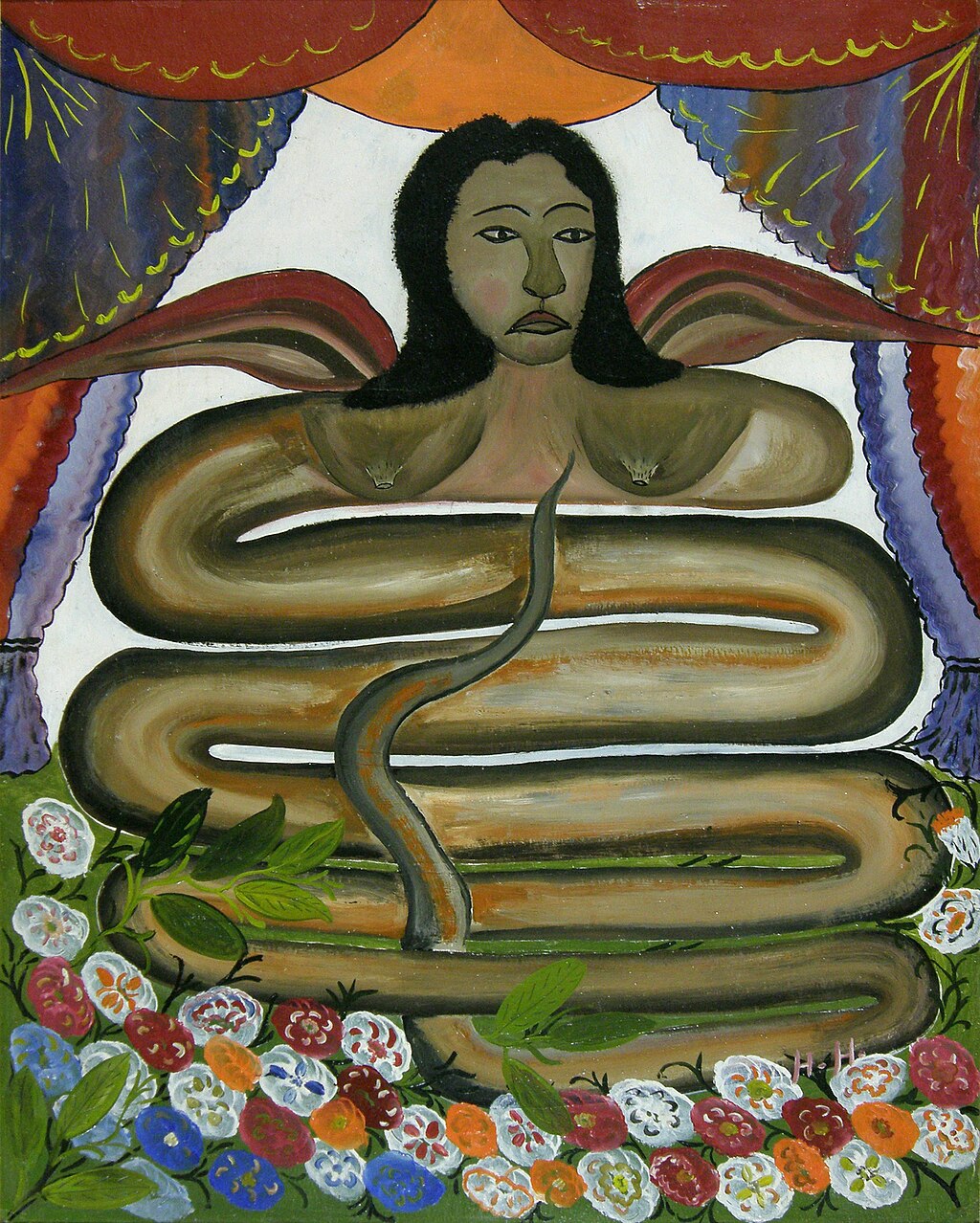 A painting of the lwa Damballa, a serpent, by Haitian artist Hector Hyppolite. Background The word "Vodou" comes from the Fon language (spoken in Dahomey) meaning "spirit" or "god". As the original practice of Haitian Vodou, tribes would worship the spirits of ancestors and believed that followers were possessed by immortal spirits. During the seventeenth century, these practices were banned by slave owners, causing the slaves to practice in private. Slave owners threatened to baptize the slaves if they did not stop worshiping Vodou. Due to these threats, slaves practiced Vodou in private while incorporating Catholic traditions into them. They incorporated hymns and prayers, which are still seen in modern day Vodou.[1] Vodou became "Voodoo" once it was brought to New Orleans' French Quarter. Once in New Orleans' aspects of Vodou changed, including the wearing of charms for protection, healing and harming others.[1] A key figure in the popularization of Vodou was Marie Laveau. Laveau lived in New Orleans during the initial times of Voodoo, becoming a pillar within the community. She learned and expanded her knowledge on Voodoo from Dr. John Bayou, a well known conjurer. Due to Laveau's popularity at the time, she was able to connect with members in her community by giving then advice and guidance.[2] She was said to have healing powers and gifting the poor.[2] Because of Laveau's popularity, her house is now a common attraction in New Orleans.[3] |
 ハイチ人アーティスト、ヘクター・イポリットによる蛇の神ダンバラーの絵画。 背景 「ヴードゥー」という言葉は、ダホメーで話されるフォン語に由来し、「霊」または「神」を意味する。 ハイチ・ヴードゥーの本来の信仰形態では、部族は先祖の霊を崇拝し、信者は不死の霊に憑依されていると信じていた。 17世紀には、これらの慣習は奴隷所有者に禁止され、奴隷たちはひそかに信仰を続けるようになった。 奴隷所有者は、ヴードゥー崇拝を止めない場合は奴隷に洗礼を施すと脅迫した。こうした脅迫により、奴隷たちはカトリックの伝統を取り入れながらヴードゥー を秘密裏に信仰するようになった。彼らは賛美歌や祈りをヴードゥーに取り入れ、それは現代のヴードゥーにも見られる。 ヴードゥーは、ニューオーリンズのフレンチ・クオーターに伝わると「ヴードゥー」と呼ばれるようになった。ニューオーリンズに伝わると、ヴードゥーの様相 は変化し、護符を身につけて身を守ったり、病気を治したり、他人に害を加えたりするようになった。[1] ヴードゥーの普及に重要な役割を果たした人物に、マリー・ルボーがいた。ルボーはヴードゥーの初期にニューオーリンズに住み、コミュニティの柱となった。 彼女は、有名な手品師であるジョン・ベイユ博士からヴードゥーの知識を学び、それを広めた。ラヴォーの人気は当時非常に高かったため、彼女は助言や指導を 与えることで地域社会のメンバーとつながることができた。[2] 彼女には治癒能力があり、貧しい人々に施しを与えていたと言われている。[2] ラヴォーの人気により、現在では彼女の家はニューオーリンズの一般的な観光名所となっている。[3] |
| Early instances One of the first books to expose Western culture to the concept of the voodoo zombie was The Magic Island (1929) by W. B. Seabrook. This is the sensationalized account of a narrator who encounters voodoo cults in Haiti and their resurrected thralls. Time commented that the book "introduced 'zombi' into U.S. speech".[4] Zombies have a complex literary heritage, with antecedents ranging from Richard Matheson and H. P. Lovecraft to Mary Shelley's Frankenstein drawing on European folklore of the undead. Victor Halperin directed White Zombie (1932), a horror film starring Bela Lugosi. Here zombies are depicted as mindless, unthinking henchmen under the spell of an evil magician. Zombies, often still using this voodoo-inspired rationale, were initially uncommon in cinema, but their appearances continued sporadically through the 1930s to the 1960s, with films including Jacques Tourneur's I Walked with a Zombie (1943),[5] and Plan 9 from Outer Space (1959). |
初期の例 西洋文化にヴードゥーのゾンビ概念を初めて紹介した書籍のひとつに、W.B.シーブルック著の『魔法の島』(1929年)がある。これは、ハイチでヴー ドゥー教のカルトと、そのカルトに支配された死者たちと遭遇した語り手のセンセーショナルな体験記である。タイム誌は、この本について「ゾンビという言葉 を米国の会話に取り入れた」と評した。[4] ゾンビは文学的にも複雑な歴史を持っており、リチャード・マシスンやH・P・ラヴクラフトから、ヨーロッパのアンデッドの民話に着想を得たメアリー・シェ リーの『フランケンシュタイン』まで、さまざまな先例がある。ビクター・ハルペリン監督の『ホワイト・ゾンビ』(1932年)は、ベラ・ルゴシ主演のホ ラー映画である。この映画では、ゾンビは邪悪な魔術師の呪文にかかった、思考力のない手下として描かれている。このヴードゥー教にインスパイアされた論理 を今でも用いるゾンビは、当初は映画ではあまり一般的ではなかったが、ジャック・ターナー監督の『私はゾンビと歩いた』(1943年)[5]や『宇宙戦 争』(1959年)など、1930年代から1960年代にかけて断続的に登場し続けた。 |
| Derivations Various scholars describe the form of the religion practiced in Haiti, Haitian Vodou, as one of the world's most maligned and misunderstood religions.[6] Its reputation is notorious;[7] in broader Anglophone and Francophone society, it has been widely associated with sorcery, witchcraft, and black magic.[8] In U.S. popular culture, for instance, Haitian Vodou is usually portrayed as destructive and malevolent,[9] attitudes sometimes linked with anti-black racism.[10] Non-practitioners have often depicted Vodou in literature, theater, and film;[11] in many cases, such as the films White Zombie (1932) and London Voodoo (2004), these promote sensationalist views of the religion.[12] The lack of any central Vodou authority has hindered efforts to combat these negative representations.[13] Two of the most pervasive representations are the creation of zombies and the use of voodoo dolls. In Haitian folklore, a zombie (Haitian French: zombi, Haitian Creole: zonbi) is an animated corpse raised by magical means, such as witchcraft.[14] The concept has been popularly associated with the religion of voodoo, but it plays no part in that faith's formal practices. Filmmaker George A. Romero, who was influential in the development of the zombie film genre, initially believed that "zombies" corresponded to the undead slaves of Haitian voodoo as depicted in White Zombie.[15] The term Voodoo doll commonly describes an effigy into which pins are inserted.[5] Such practices are found in various forms in the magical traditions of many cultures around the world.[5] Although the use of the term Voodoo implies that the practice is linked to Haitian Vodou or Louisiana Voodoo, the voodoo doll is not prominent in either.[5] The link between this magical practice and Voodoo was established through the presentation of the latter in Western popular culture, enduring the first half of the 20th century.[5] In this, the myth of this magical practice being closely linked to Voodoo and Vodou was promoted as part of the wider negative depictions of blacks and Afro-Caribbean religious practices in the United States.[16] In John Houston Craige's 1933 book Black Bagdad: The Arabian Nights Adventures of a Marine Captain in Haiti, he described a Haitian prisoner sticking pins into an effigy to induce illness.[5] Its use also appeared in film representations of Haitian Vodou such as Halperin's White Zombie, and Tourneur's I Walked with a Zombie.[5] Voodoo dolls are also featured in the films Lisztomania and Indiana Jones and the Temple of Doom, though the latter is in connection with a fictionalized Indian Thuggee religion entirely unrelated to Voodoo. By the early 21st century, the image of the voodoo doll had become particularly pervasive.[5] It had become a novelty item available for purchase, with examples being provided in vending machines in British shopping centres,[5] and an article on "How to Make a Voodoo Doll" being included on WikiHow.[17][5] A voodoo doll had also been included in the 2009 animated Disney movie, The Princess and the Frog,[5] as well as the 2011 live-action Disney movie Pirates of the Caribbean: On Stranger Tides. |
派生 ハイチで信仰されている宗教の形態であるハイチ・ヴードゥーは、世界で最も不当に扱われ、誤解されている宗教のひとつであると、さまざまな学者が述べてい る。[6] その評判は悪名高く、[7] 英語圏やフランス語圏の社会では、広く魔術、魔女、黒魔術と関連付けられている。[8] 例えば、米国のポップカルチャーでは、ハイチ・ヴードゥーは通常、破壊的で悪意があると描写され、[9] 時には反黒人種主義と結びつけられることもある。[10] ヴードゥー教を信仰していない人々によって、文学、演劇、映画でヴードゥー教が描かれることも多い。[11] 映画『ホワイト・ゾンビ』(1932年)や『ロンドン・ヴードゥー』(2004年)など、多くの場合、これらの作品はセンセーショナルな宗教観を広めてい る。[12] ヴードゥー教の中央当局が存在しないため、こうした否定的な表現と戦う取り組みが妨げられている。[13] 最も広く浸透しているイメージの2つは、ゾンビの創造とブードゥー教の人形の使用である。ハイチ民話において、ゾンビ(ハイチ・フランス語:ゾンビ、ハイ チ・クレオール語:ゾンビ)とは、呪術などの呪術的な手段によって生き返った死体を指す。[14] この概念は一般的にブードゥー教と関連付けられているが、その信仰の正式な実践には何ら関係していない。ゾンビ映画というジャンルを確立させた映画監督 ジョージ・A・ロメロは当初、「ゾンビ」とは『ホワイト・ゾンビ』に描かれたハイチ・ブードゥー教のアンデッドの奴隷に相当するものだと考えていた。 [15] 「ブードゥー人形」という用語は一般的に、ピンが刺さっている人形を指す。[5] このような慣習は、 世界中の多くの文化の呪術的伝統に見られる。[5] ヴードゥーという用語の使用は、その慣習がハイチ・ブードゥー教やルイジアナ・ブードゥー教と関連していることを暗示しているが、ブードゥー教の人形はど ちらでも目立ったものではない。[5] この呪術的慣習とブードゥー教の関連性は、20世紀前半まで続いた西洋のポピュラーカルチャーにおける後者の表現を通じて確立された 20世紀前半を通じて定着した。[5] この呪術的実践の神話は、ヴードゥーやブードゥーと密接に関連しているとされ、米国における黒人やアフリカ系カリブ人の宗教的実践に対する否定的な描写の 一部として広まった。[16] ジョン・ヒューストン・クレイグの1933年の著書『ブラック・バグダッド: ハイチにおける海兵隊大尉の『アラビアンナイト』冒険記』の中で、彼は、病気を引き起こすために人形に針を刺すハイチの囚人について記述している。[5] その使用は、ハルペリンの『ホワイト・ゾンビ』や、ターネーの『 『私はゾンビと歩いた』などにも登場している。[5] ブードゥー教の人形は、映画『リズモマニア』や『インディ・ジョーンズ/魔宮の伝説』にも登場しているが、後者はブードゥー教とは全く関係のない架空のイ ンドの宗教であるスグジー教に関連している。 21世紀初頭までに、ヴードゥー人形のイメージは特に広まっていた。[5] 購入可能なノベルティ商品となり、イギリスのショッピングセンターの自動販売機でも販売されていた。[5] また、「ヴードゥー人形の作り方」という記事が ウィキハウに掲載された。[17][5] 2009年のディズニーアニメ映画『プリンセスと魔法のキス』にもヴードゥー人形が登場している。[5] また、2011年の実写版ディズニー映画『パイレーツ・オブ・カリビアン/生命の泉』にも登場している。 |
| Closer representations More accurate representations of Voodoo occur in connection with the popular culture of regions where Voodoo is actually practiced. Humanity's relationship with spirits known as lwa has been a recurring theme in Haitian art,[18] and the Vodou pantheon was a major topic for the mid-20th century artists of the "Haitian Renaissance."[19] Art collectors began to take an interest in Vodou ritual paraphernalia in the late 1950s, and by the 1970s an established market for this material had emerged,[20] with some material being commodified for sale abroad.[21] Exhibits of Vodou ritual material have been displayed abroad; the Fowler Museum's exhibit on "Sacred Arts of Haitian Vodou" for instance traveled the U.S. for three years in the 1990s.[22] Vodou has appeared in Haitian literature,[23] and has also influenced Haitian music, as with the rock band Boukman Eksperyans,[24] while theatre troupes have performed simulated Vodou rituals for audiences outside Haiti.[25] Documentaries focusing on Vodou have appeared[26]—such as Maya Deren's 1985 film Divine Horsemen[27] or Anne Lescot and Laurence Magloire's 2002 work Of Men and Gods[28]—which have in turn encouraged some viewers to take a practical interest in the religion.[29] |
より身近な表現 ヴードゥーのより正確な表現は、実際にヴードゥーが信仰されている地域のポピュラーカルチャーに関連して見られる。人間と「ルワ」として知られる精霊との 関係は、ハイチ美術における繰り返し登場するテーマであり[18]、ヴードゥーの神々は「ハイチ・ルネサンス」の20世紀中頃の芸術家たちにとって主要な テーマであった[19]。美術品の収集家たちは1950年代後半からヴードゥーの儀式用具に関心を寄せるようになり、1970年代にはこの種の物品の市場 が確立され[20]、 。ヴードゥー教の儀式で使用される物品の展示は海外でも行われており、例えば、1990年代には「ハイチ・ヴードゥーの聖なる芸術」と題されたファウラー 博物館の展示が3年間アメリカ国内を巡回した。[22] ヴードゥー教はハイチ文学にも登場しており[23]、ロックバンドのブークマン・エクスペリヤンスのように、ハイチ音楽にも影響を与えている 。また、劇団がヴードゥー教の儀式を模したものをハイチ国外の観客のために上演したこともある[25]。ヴードゥー教をテーマにしたドキュメンタリー映画 も制作されている[26]。例えば、マヤ・デレン監督の1985年の映画『Divine Horsemen』[27]や、アン・レスコットとローレンス・マグロア監督の2002年の作品『Of Men and Gods』[28]などである。これらのドキュメンタリー映画は、一部の観客にこの宗教への実質的な関心を持たせるきっかけとなった[29]。 |
| Misconceptions Modern day Voodoo is usually associated with satanism and witchcraft. This is because of how voodoo is presented in media and pop culture. In pop culture, Voodoo is often portrayed as "black magic" and placing "hexes". Along with witchcraft, Vodou is commonly connected with harm and animal sacrifice, the main use for Vodou is healing. Haitian Vodou focuses on healing by attempting to expel evil spirits from within the body.[30] |
誤解 現代のヴードゥー教は、通常、悪魔主義や呪術と関連付けられる。これは、メディアやポップカルチャーにおけるヴードゥー教の描写によるものである。ポップ カルチャーでは、ヴードゥー教はしばしば「黒魔術」や「呪い」として描かれる。呪術とともに、ヴードゥー教は一般的に害や動物生贄と結び付けられるが、 ヴードゥー教の主な用途は癒しである。ハイチ・ヴードゥー教は、体内の悪霊を追い出すことで癒しに重点を置いている。[30] |
| Armitage, Natalie (2015).
"European and African Figural Ritual Magic: The Beginnings of the
Voodoo Doll Myth". In Ceri Houlbrook; Natalie Armitage (eds.). The
Materiality of Magic: An Artifactual Investigation into Ritual
Practices and Popular Beliefs. Oxford: Oxbow. pp. 85–101. Boutros, Alexandra (2011). "Gods on the Move: The Mediatisation of Vodou". Culture and Religion. 12 (2): 185–201. doi:10.1080/14755610.2011.579718. S2CID 144434687. Brown, Karen McCarthy (1991). Mama Lola: A Vodou Priestess in Brooklyn. Berkeley: University of California Press. ISBN 0-520-22475-2. Cosentino, Donald (1996). "Doing Vodou". African Arts. 29 (2): 1–14. doi:10.2307/3337357. JSTOR 3337357.} Cosentino, Donald (2009). "Vodou: A Way of Life". Material Religion. 5 (2): 250–252. doi:10.2752/174322009X12448040552160. S2CID 191333249. Desmangles, Leslie (1992). The Faces of the Gods: Vodou and Roman Catholicism in Haiti. Chapel Hill: University of North Carolina Press. ISBN 978-0807843932. Fandrich, Ina J. (2007). "Yorùbá Influences on Haitian Vodou and New Orleans Voodoo". Journal of Black Studies. 37 (5): 775–791. doi:10.1177/0021934705280410. JSTOR 40034365. S2CID 144192532. Faraone, Christopher A. (1991). "Binding and Burying the Forces of Evil: The Defensive Use of "Voodoo Dolls" in Ancient Greece". Classical Antiquity. 10 (2): 165–202. doi:10.2307/25010949. JSTOR 25010949. Fernández Olmos, Margarite; Paravisini-Gebert, Lizabeth (2011). Creole Religions of the Caribbean: An Introduction from Vodou and Santería to Obeah and Espiritismo (second ed.). New York and London: New York University Press. ISBN 978-0-8147-6228-8. Girouard, Tina (1995). "The Sequin Arts of Vodou". In Donald J., Cosentino (ed.). Sacred Arts of Haitian Vodou. Los Angeles: UCLA Fowler Museum of Cultural History. pp. 357–377. ISBN 0-930741-47-1. Hammond, Charlotte (2012). ""Children" of the Gods: Filming the Private Rituals of Haitian Vodou". Journal of Haitian Studies. 18 (2): 64–82. JSTOR 41949204. McAlister, Elizabeth (1995). "A Sorcerer's Bottle: The Visual Art of Magic in Haiti". In Donald J., Cosentino (ed.). Sacred Arts of Haitian Vodou. Los Angeles: UCLA Fowler Museum of Cultural History. pp. 305–321. ISBN 0-930741-47-1. Archived from the original on 2015-05-05. Retrieved 2015-05-03. Hutton, Ronald (1999). The Triumph of the Moon: A History of Modern Pagan Witchcraft. Oxford: Oxford University Press. ISBN 0-19-820744-1. Wilcken, Lois (2005). "The Sacred Music and Dance of Haitian Vodou from Temple to Stage and the Ethics of Representation". Latin American Perspectives. 32 (1): 193–210. doi:10.1177/0094582X04271880. JSTOR 30040235. S2CID 144260390. |
Armitage, Natalie (2015).
「European and African Figural Ritual Magic: The Beginnings of the
Voodoo Doll Myth」. In Ceri Houlbrook; Natalie Armitage (eds.). The
Materiality of Magic: An Artifactual Investigation into Ritual
Practices and Popular Beliefs. Oxford: Oxbow. pp. 85–101. Boutros, Alexandra (2011). 「Gods on the Move: The Mediatisation of Vodou」. Culture and Religion. 12 (2): 185–201. doi:10.1080/14755610.2011.579718. S2CID 144434687. ブラウン、カレン・マッカーシー(1991年)。Mama Lola: A Vodou Priestess in Brooklyn. バークレー: カリフォルニア大学出版局. ISBN 0-520-22475-2. Cosentino, Donald (1996). 「Doing Vodou」. African Arts. 29 (2): 1–14. doi:10.2307/3337357. JSTOR 3337357.} Cosentino, Donald (2009). 「Vodou: A Way of Life」. Material Religion. 5 (2): 250–252. doi:10.2752/174322009X12448040552160. S2CID 191333249. デスマンジュ、レスリー(1992年)。『神々の顔:ハイチにおけるヴードゥー教とローマ・カトリック』。チャペルヒル:ノースカロライナ大学出版。 ISBN 978-0807843932。 ファンドリッチ、イナ・J.(2007年)。「ハイチ・ヴードゥーとニューオーリンズ・ヴードゥーにおけるヨルバ族の影響」。Journal of Black Studies. 37 (5): 775–791. doi:10.1177/0021934705280410. JSTOR 40034365. S2CID 144192532. Faraone, Christopher A. (1991). 「Binding and Burying the Forces of Evil: The Defensive Use of 」Voodoo Dolls「 in Ancient Greece」. Classical Antiquity. 10 (2): 165–202. doi:10.2307/25010949. JSTOR 25010949. フェルナンデス・オルモス、マーガレット、リザベス・パラヴィシーニ=ゲバート著『カリブのクレオール宗教:ヴードゥーとサンテリアからオベアとエスピリ チュイズムへの入門』(第2版)。ニューヨークおよびロンドン:ニューヨーク大学出版。ISBN 978-0-8147-6228-8。 ギルウォード、ティナ(1995年)。「ヴードゥーの装飾芸術」。ドナルド・J・コセンティーノ編。『ハイチ・ヴードゥーの聖なる芸術』。ロサンゼルス: UCLAファウラー文化史博物館。357-377ページ。ISBN 0-930741-47-1。 Hammond, Charlotte (2012). 「」Children「 of the Gods: Filming the Private Rituals of Haitian Vodou」. Journal of Haitian Studies. 18 (2): 64–82. JSTOR 41949204. マカリスター、エリザベス(1995年)。「魔術師のボトル:ハイチにおける呪術の視覚芸術」。ドナルド・J・コセンティーノ編『ハイチ・ヴードゥーの聖 なる芸術』ロサンゼルス:UCLAファウラー文化史博物館。305-321ページ。ISBN 0-930741-47-1。2015年5月5日オリジナルよりアーカイブ。2015年5月3日取得。 ハットン、ロナルド(1999年)。『月の勝利:近代ペイガニズムの魔術の歴史』。オックスフォード:オックスフォード大学出版局。ISBN 0-19-820744-1。 ウィルケン、ロイス(2005年)。「ハイチ・ヴードゥーの神殿から舞台へ:神聖な音楽と舞踏と表象の倫理」。ラテンアメリカ研究の視点。32(1): 193-210。doi:10.1177/0094582X04271880。JSTOR 30040235。S2CID 144260390。 |
1932
年の映画『ホワイト・ゾンビ(邦題:恐怖城)』は、ヴードゥーに関するいくつかの架空の要素を生み出した。
The 1932 film White Zombie originated several fictional tropes
regarding Voodoo.
★ ダンシング・ヴードゥー : ハイチを彩る精霊たち / 佐藤文則著、凱風社 , 2003年の書肆宣伝文句
「ハ イチ文化理解に不可欠のヴードゥーの実体をルポ。/ 2004年1月1日に独立200年を迎えるハイチは、世界初の黒人共和国です(西半球ではアメリカに次ぐ二番目の独立国)。日本で「ハイチって?」と聞け ば、音楽や絵という答えが平均的なところ。映画の中に出てくる偏見に満ちたゾンビ像や、「世界最貧国」って言う答えもありそう――。著者は前作『ハイチ:目覚めたカリブの黒人共和国』(凱風社)でハイチの成り立ちや民主化への歩みを明らかにしましたが、本書では、庶民の精神文化の理解に不可欠のヴードゥーの実体を克明に記録しました。精霊が憑依した人の眼ってスゴイんです。写真80点余掲載。カラー16点。」
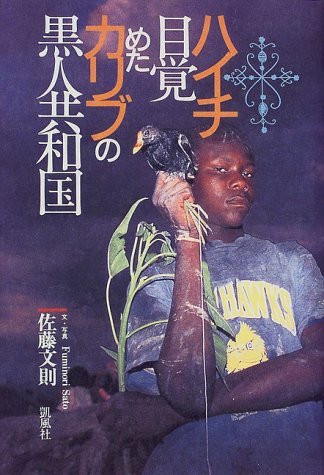

リ ンク
文 献
そ の他の情報
CC
Copyleft, CC, Mitzub'ixi Quq Chi'j, 1996-2099
☆
 ☆
☆